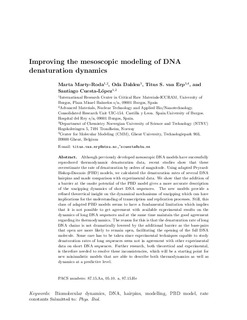| dc.contributor.author | Marty-Roda, Marta | |
| dc.contributor.author | Dahlen, Oda | |
| dc.contributor.author | van Erp, Titus Sebastiaan | |
| dc.contributor.author | Cuesta-Lopez, Santiago | |
| dc.date.accessioned | 2019-04-11T15:10:28Z | |
| dc.date.available | 2019-04-11T15:10:28Z | |
| dc.date.created | 2018-12-17T13:42:15Z | |
| dc.date.issued | 2018 | |
| dc.identifier.citation | Physical Biology. 2018, 15 (6), . | nb_NO |
| dc.identifier.issn | 1478-3967 | |
| dc.identifier.uri | http://hdl.handle.net/11250/2594322 | |
| dc.description.abstract | Although previously developed mesoscopic DNA models have successfully reproduced thermodynamic denaturation data, recent studies show that these overestimate the rate of denaturation by orders of magnitude. Using adapted Peyrard–Bishop–Dauxois (PBD) models, we have calculated the denaturation rates of several DNA hairpins and made comparison with experimental data. We show that the addition of a barrier at the onsite potential of the PBD model gives a more accurate description of the unzipping dynamics of short DNA sequences. The new models provide a refined theoretical insight on the dynamical mechanisms of unzipping which can have implications for the understanding of transcription and replication processes. Still, this class of adapted PBD models seems to have a fundamental limitation which implies that it is not possible to get agreement with available experimental results on the dynamics of long DNA sequences and at the same time maintain the good agreement regarding its thermodynamics. The reason for this is that the denaturation rate of long DNA chains is not dramatically lowered by the additional barrier—as the base-pairs that open are more likely to remain open, facilitating the opening of the full DNA molecule. Some care has to be taken, since experimental techniques suitable to the study of denaturation rates of long sequences seem not to agree with other experimental data on short DNA sequences. Further research, both theoretical and experimental, is therefore needed to resolve these inconsistencies—which will be a starting point for new minimalistic models that are able to describe both thermodynamics and dynamics at a predictive level. | nb_NO |
| dc.language.iso | eng | nb_NO |
| dc.publisher | IOP Publishing | nb_NO |
| dc.title | Improving the mesoscopic modeling of DNA denaturation dynamics | nb_NO |
| dc.type | Journal article | nb_NO |
| dc.type | Peer reviewed | nb_NO |
| dc.description.version | acceptedVersion | nb_NO |
| dc.source.pagenumber | 11 | nb_NO |
| dc.source.volume | 15 | nb_NO |
| dc.source.journal | Physical Biology | nb_NO |
| dc.source.issue | 6 | nb_NO |
| dc.identifier.doi | 10.1088/1478-3975/aac61c | |
| dc.identifier.cristin | 1644198 | |
| dc.description.localcode | This is an author-created, un-copyedited version of an article accepted for publication/published in Physical Biology. Locked until 20.6.2019 due to copyright restrictions. IOP Publishing Ltd is not responsible for any errors or omissions in this version of the manuscript or any version derived from it. The Version of Record is available online at: http://dx.doi.org/10.1088/1478-3975/aac61c | nb_NO |
| cristin.unitcode | 194,66,25,0 | |
| cristin.unitname | Institutt for kjemi | |
| cristin.ispublished | true | |
| cristin.fulltext | postprint | |
| cristin.qualitycode | 1 | |
